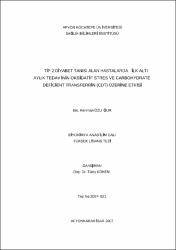| dc.contributor.advisor | Köken, Tülay | |
| dc.contributor.author | Özuğur, Keriman | |
| dc.date.accessioned | 2015-05-14T10:54:08Z | |
| dc.date.available | 2015-05-14T10:54:08Z | |
| dc.date.issued | 2007 | |
| dc.date.submitted | 2007 | |
| dc.identifier.uri | http://hdl.handle.net/11630/4051 | |
| dc.description.abstract | Diabetes mellitus (DM), endojen insülinin mutlak veya göreceli eksikliği veya
periferik etkisizliği sonucu ortaya çıkan kronik, progresif bir hastalıktır. İnsülin
direnci; eksojen ve endojen insülinin etkilerine biyolojik yanıtın bozukluğu
anlamına gelir ve tip 2 DM’nin patofizyolojisindeki temel sebeplerden biridir.
Bu çalışmanın amacı rutin alkol alımının bir göstergesi olarak kullanılan
Carbohydrate deficient transferinin (CDT) yeni bir parametre olarak DM
izleminde kullanılıp kullanılamayacağının araştırılmasıdır.
Çalışmaya, Tip 2 DM tanısı konulan 15 kişiden hasta grubu (70 yasın
altında; 9 kadın, 6 erkek), sağlıklı gönüllü 15 kişiden de (70 yasın altında; 9
kadın, 6 erkek) kontrol grubu oluşturuldu. Çalışmaya alınan hastalara
metformin (2 gr/gün) veya roziglitazon (8 mg/gün) tedavisi uygulandı.
Hastaların tedavi öncesi, tedavi başladıktan sonra 3. ay, 6. ay kan
örnekleri alındı. Hasta ve kontrol grubundan alınan tüm kan örneklerinden
malondialdehid (MDA), protein karbonil, sülfidril (SH) grupları, nitrik oksit
(NO), % CDT, glukoz, insülin, fruktozamin, HbA1c ve düzeyleri ölçüldü ve
insülin dirençleri hesaplandı.
Yapılan çalışmalar sonucunda DM’ li hastalarda kontrol grubuna göre
artmış MDA, NO, glukoz, fruktozamin, HbA1c ve insülin direnci düzeyleri
gözlendi. Tedavi öncesi serum sülfidril ve karbonil düzeyleri, 3.ay’da ve
6.ay’da belirgin bir düşüş göstermesine rağmen kontrol grubu ile anlamlı bir
fark gözlenmedi. Diabetik hastaların % CDT ve insülin düzeylerinde anlamlı
bir fark gözlenmedi
Bu sonuçlara göre, diyabette lipid peroksidasyonunun arttığı ve
antioksidan mekanizmaları etkilediği görüldü. Oksidatif stresin azalma
sebebinin tedavi sonrası hipergliseminin azalmasından mı yoksa antioksidan
özellikleri olan antidiyabetik ilaçların kullanımından mı kaynaklandığını bize
düşündürmektedir. | en_US |
| dc.description.abstract | Diabetes mellitus (DM) is a chronic, progressive disease come out as a result
of the absolute or the relative lack of endogenous insulin or ineffectiveness of
it. Insulin resistance means the defect in the biological response to the
effects of exogenous or endogenous insulin and it is one of the main reasons
in the pathophysiology of type 2 DM. Metformin and rosiglitazone show their
main antidiabetic effects by reducing insulin resistance.
The objective of this study is investigating whether CDT used as an
indicator of alcohol intake may be used as a new parameter in the follow-up
of Diabetes Mellitus (DM).
For this purpose, the patient group including fifteen patients (under 70
years old; 9 female, 6 male) with Type II DM and the control group including
fifteen healthy volunteer (under 70 years old; 9 female, 6 male) were included
in the study. Metformin (2 g/day) or rosiglitazon (8 mg/day) treatments were
applied for the patients included in the study.
Blood samples were drawn from the patients before the treatment, 3
and 6 months after the beginning time of the treatment. In all the blood
samples of the patient and the control groups, Malondialdehyde (MDA),
protein carbonyl, sulfhydryl (SH) groups, nitric okside (NO), CDT %, glucose,
fructose amine, HbA1c levels were measured and insulin resistances were
calculated.
As a result of the studies performed, in the patients with DM increased
MDA, NO, glucose, fructose amine, HbA1c and insulin resistance levels
were observed when compared with the control group. Although serum
sulfhydryl and carbonyl levels showed a prominent decrease in the 3th and
the 6th months before the treatment, no significant difference was observed
between the patient and the control groups. No significant difference was
observed in the CDT % and the insulin levels of the diabetic patients.
XV
According to these results, in diabetes it was seen that lipid
peroxidation was increased and this affected the antioxidant mechanisms.
This made us think whether the reason of the decrease in the oxidative
stress was due to the decrease of hyperglycemia after the treatment or due
to the intake of antidiabetic drugs with antioxidant properties. | en_US |
| dc.language.iso | tur | en_US |
| dc.publisher | Afyon Kocatepe Üniversitesi, Sağlık Bilimleri Enstitüsü | en_US |
| dc.rights | info:eu-repo/semantics/openAccess | en_US |
| dc.subject | CDT | en_US |
| dc.subject | Tip 2 DM | en_US |
| dc.subject | Oksidatif Stres | en_US |
| dc.title | Tip 2 Diyabet Tanısı Alan Hastalarda İlk Altı Aylık Tedavinin Oksidatif Stres ve Carbohydrate Deficient Transferrin (CDT) Üzerine Etkisi | en_US |
| dc.title.alternative | The Effect of Diabet Treatment on Oxidative Stres and Carbohydrate- Deficient Transferrin (CDT) ın Diabetic Patients | en_US |
| dc.type | masterThesis | en_US |
| dc.department | Afyon Kocatepe Üniversitesi, Sağlık Bilimleri Enstitüsü, Tıp Biyokimya Bölümü | en_US |
| dc.relation.publicationcategory | Tez | en_US |



















